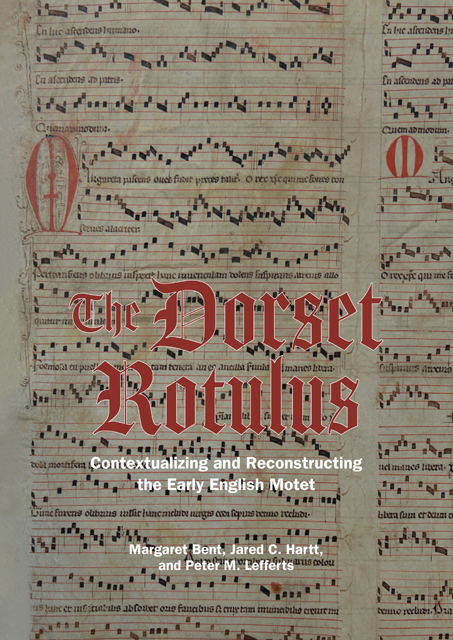Book contents
- Frontmatter
- Contents
- List of Figures
- List of Music Examples
- List of Tables
- Abbreviations
- Note on the Transcriptions
- Introduction
- 1 The Source and its Contents
- 2 Contexts and Designs
- 3 Voice-Exchange Motets and Ascendenti sonet geminacio/ Viri Galilei
- 4 Margareta pascens oves and its Large-Scale Comparands
- 5 Rota versatilis: Towards a Reconstruction
- 6 The Curious Case of Regina preminencie/ Gemma nitens/ … mater es intacta
- 7 Introducing Naufragantes visita/ Navigatrix inclita/ T. Aptatur/ … velox perpetrat
- 8 The Musical Rotulus: Artifact, Image, and Attributes
- 9 Epilogue: Conclusions and Speculation
- Appendix: Transcriptions, Texts, and Translations of the Four Dorset Motets
- Bibliography
- Index of Manuscripts
- Index of Musical Compositions
- General Index
- Studies in Medieval and Renaissance Music
6 - The Curious Case of Regina preminencie/ Gemma nitens/ … mater es intacta
Published online by Cambridge University Press: 14 January 2023
- Frontmatter
- Contents
- List of Figures
- List of Music Examples
- List of Tables
- Abbreviations
- Note on the Transcriptions
- Introduction
- 1 The Source and its Contents
- 2 Contexts and Designs
- 3 Voice-Exchange Motets and Ascendenti sonet geminacio/ Viri Galilei
- 4 Margareta pascens oves and its Large-Scale Comparands
- 5 Rota versatilis: Towards a Reconstruction
- 6 The Curious Case of Regina preminencie/ Gemma nitens/ … mater es intacta
- 7 Introducing Naufragantes visita/ Navigatrix inclita/ T. Aptatur/ … velox perpetrat
- 8 The Musical Rotulus: Artifact, Image, and Attributes
- 9 Epilogue: Conclusions and Speculation
- Appendix: Transcriptions, Texts, and Translations of the Four Dorset Motets
- Bibliography
- Index of Manuscripts
- Index of Musical Compositions
- General Index
- Studies in Medieval and Renaissance Music
Summary
The verso of the Dor rotulus contains substantial fragments of two more motets, Regina/Gemma and Naufragantes/Navigatrix. In contrast to Ascendenti/Viri and Margareta on the recto, and Rota versatilis (Chapters 3, 4, and 5), these two compositions are not voice-exchange motets. Each has a unique method of construction, relationship between voices, and approach to employing a cantus prius factus.
Regina/Gemma, the subject of this chapter, is the lone three-voice motet on the rotulus. Remarkably, the motet presents a cogently tuneful, texted melody in its middle voice, to which independently texted top and bottom voices are coordinated. Because we will propose that the middle voice was the starting point for Regina/Gemma, and since a ‘tenor’ label for the lowest voice of a stratified three-voice motet such as this often has the connotation of being a cantus prius factus, we instead identify the voices here as Cantus I, II, and III (from highest to lowest). The wordier, rhythmically more active Cantus I draws upon melodic and textual elements from Cantus II, and Cantus III moves more slowly below. All three texts honor the Blessed Virgin Mary. Portions of the motet survive in two additional manuscripts; a comparison of all three sources invites questions of genesis and genre. Although lacunae remain, this unusual motet is of great interest, not only because of its middle-voice cantus prius factus and its texted, occasionally droning Cantus III, but also because significant portions of the motet exist elsewhere as a two-voice conductus. It will be argued that the conductus was created from the motet, yet the number and variety of variants between them complicate the picture.
What Survives
Several segments of Cantus III and intermittent parts of Cantus I are missing because of the gap between av and bv of Dor, and due to the trimming of the left-hand column of the two membranes (Figures 1.3 and 1.4). Fortunately, however, because the entirety of Cantus II survives, we know the motet consists of 144L (see Example 6.6, a transcription of the motet). Two concordances, Cgc 512 and Lbl 3132, preserve various portions of Regina/Gemma, and help to fill most of the missing portions of the music of the lowest voice (but only a few words of its text) and a small amount of music and text of Cantus I.
- Type
- Chapter
- Information
- The Dorset RotulusContextualizing and Reconstructing the Early English Motet, pp. 213 - 254Publisher: Boydell & BrewerPrint publication year: 2021

